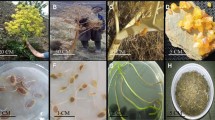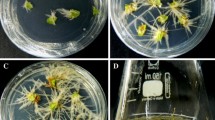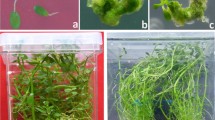Abstract
An efficient protocol for hairy root induction in radish was established by optimizing several parameters that affect the efficiency of Agrobacterium rhizogenes-mediated transformations. Explants wounded using sterile hypodermic needle, infected with Agrobacterium suspension (0.6 OD600) for 10 min and co-cultivated in 1/2 MS medium containing acetosyringone (100 µM) for 2 days displayed maximum percentage of hairy root induction using MTCC 2364 (77.6%) and MTCC 532 (67.6%). On further experiments with MTCC 2364 initiated hairy roots, maximum biomass accumulation (fresh weight = 9.50 g; dry weight = 1.48 g) was achieved in liquid 1/2 MS medium supplemented with 87.6 mM sucrose after 40 days of culture. Transgenic state of hairy roots of MTCC 2364 was confirmed by polymerase chain reaction using rolB- and rolC-specific primers. The MTCC 2364-induced hairy roots produced higher amount of phenolic (33.0 mg g−1), flavonoid (48.0 mg g−1), and quercetin (114.8 mg g−1) content compared to auxin-induced roots of non-transformed radish. Furthermore, the results of ferric reducing antioxidant power and 1,1-diphenyl-2-picrylhydrazyl assay confirmed that the antioxidant activity of MTCC 2364 root extracts was improved when compared to auxin-induced roots of non-transformed radish. The present study offers a new insight in radish for production of phenolics and flavonoids (quercetin) using A. rhizogenes-mediated hairy root induction.





Similar content being viewed by others
References
Aggarwal D, Jaiswal N, Kumar A, Reddy MS (2013) Factors affecting genetic transformation and shoot organogenesis of Bacopa monnieri (L.) Wettst. J Plant Biochem Biotechnol 22:382–391
Aguirre L, Arias N, Macarulla MT, Gracia A, Portillo MP (2011) Beneficial effects of quercetin on obesity and diabetes. Open Nutraceuticals J 4:189–198
An X, Wang B, Liu L, Jiang H, Chen J, Ye S, Chen L, Guo P, Huang X, Peng D (2014) Agrobacterium-mediated genetic transformation and regeneration of transgenic plants using leaf midribs as explants in ramie (Boehmeria nivea (L.) Gaud). Mol Biol Rep 41(5):3257–3269
Bae H, Kim YB, Park NI, Kim HH, Kim YS, Park U, Lee MY (2012) Agrobacterium rhizogenes-mediated genetic transformation of radish (Raphanus sativus L. cv. Valentine) for accumulation of anthocyanin. POJ 5(4):381–385
Bansal M, Kumar A, Sudhakara Reddy M (2014) Influence of Agrobacterium rhizogenes strains on hairy root induction and ‘bacoside A’ production from Bacopa monnieri (L.) Wettst. Acta Physiol Plant 36:2793–2801
Benzie IFF, Strain JJ (1996) The ferric reducing ability of plasma as a measure of antioxidant power: the FRAP assay. Anal Biochem 239:70–76
Brijwa L, Tamta S (2015) Agrobacterium rhizogenes mediated hairy root induction in endangered Berberis aristata DC. Springer Plus 4:443
Bulgakov VP (2008) Functions of rol genes in plant secondary metabolism. Biotechnol Adv 26:318–324
Chen LH, Zhang B, Xu ZQ (2008) Salt tolerance conferred by overexpression of Arabidopsis vacuolar Na+/H+ antiporter gene AtNHX1 in common buckwheat (Fagopyrum esculentum). Transgenic Res 17:121–132
Chiang M, Kurmoo Y, Khoo TJ (2017) Chemical and cell-based antioxidant capacity of methanolic extracts of three commonly edible plants from Zingiberaceae family. JFRA 7:57–62
Cho HJ, Widholm JM, Tanaka N, Nakanishi Y, Murooka Y (1998) Agrobacterium rhizogenes-mediated transformation and regeneration of the legume Astragalus sinicus (Chinese milk vetch). Plant Sci 138:53–65
Chung DH, Kim SH, Myung N, Cho KJ, Chang MJ (2012) The antihypertensive effect of ethyl acetate extract of radish leaves in spontaneously hypertensive rats. Nutr Res Pract 6(4):308–314
Chung I-M, Rekha K, Thiruvengadam M (2016) Production of glucosinolates, phenolic compounds and associated gene expression profiles of hairy root cultures in turnip (Brassica rapa ssp. rapa). 3 Biotech 6:175
Cincin ZB, Unlu M, Kiran B, Bireller ES, Baran Y, Cakmakoglu B (2014) Apoptotic effects of quercitrin on DLD-1 colon cancer cell line. Pathol Oncol Res 21(2):333–338
Crozier A, Jensen E, Lean MEJ, McDonald MS (1997) Quantitative analysis of flavonoids by reversed phase high-performance liquid chromatography. J Chromatogr A 761(1–2):315–321
Ebrahimzadeh MA, Pourmoard F, Hafezi S (2008) Antioxdant activities of Iranian corn silk. Turk J Biol 32:43–49
Egert S, Bosy-Westphal A, Seiberl J, Kürbitz C, Settler U, Plachta-Danielzik S, Wagner AE, Frank J, Schrezenmeir J, Rimbach G, Wolffram S, Müller MJ (2009) Quercetin reduces systolic blood pressure and plasma oxidised low-density lipoprotein concentrations in overweight subjects with a high-cardiovascular disease risk phenotype: a double-blinded, placebo-controlled crossover study. Br J Nutr 102(7):1065–1074
El-Esawi MA, Elshikh M, Elkelish A, Witczak J, Elansary HO, Ahmad M (2017) Genetic transformation and hairy root induction enhance the antioxidant potential of Lactuca serriola (L.). Oxidative Med Cell Longev. https://doi.org/10.1155/2017/5604746
Ercan AG, Taskin KM, Turgut K, Yuce S (1999) Agrobacterium rhizogenes mediated hairy root formation in some Rubia tinctorum L. populations grown in Turkey. Turk J Bot 23:373–377
Escudero J, Hohn B (1997) Transfer and integration of T-DNA without cell injury in the host plant. Plant Cell 9:2135–2142
Gamborg OL, Miller RA, Ojima K (1968) Nutrient requirements of suspension cultures of soybean root cells. Exp Cell Res 50(1):151–158
Gao Y, Wang Y, Ma Y, Yu A, Cai F, Shao W, Zhai G (2009) Formulation optimization and in situ absorption in rat intestinal tract of quercetin-loaded micro emulsion. Colloids Surf B 71:306–314
Georgiev MI, Pavlov AI, Bley T (2007) Hairy root type plant in vitro systems as sources of bioactive substances. Appl Microbiol Biotechnol 74:1175–1185
Ghayur MN, Gilani AH (2006) Radish seed extract mediates its cardiovascular inhibitory effects via muscarinic receptor activation. Fundam Clin Pharmacol 20(1):57–63
Guillon S, Guiller JT, Pati PK, Rideau M, Gantet P (2006) Hairy root research recent scenario and exciting prospects. Curr Opin Plant Biol 9:341–346
Gyamfi MA, Yonamine M, Aniya Y (1999) Free-radical scavenging action of medicinal herbs from Ghana: Thonningia sanguinea on experimentally induced liver injuries. Gen Pharmacol 32(6):661–667
Hashemzaei M, Far AD, Yari A, Heravi RE, Tabrizian K, Taghdisi SM, Sadegh SE, Tsarouhas K, Kouretas D, Tzanakakis G, Nikitovic D, Anisimov NY, Spandidos DA, Tsatsakis AM, Rezaee R (2017) Anticancer and apoptosis-inducing effects of quercetin in vitro and in vivo. Oncol Rep 38:819–828
Hu ZB, Du M (2006) Hairy root and its application in plant genetic engineering. J Integr Plant Biol 48(2):121–127
Huang X, Yao J, Zhao Y, Xie D, Jiang X, Xu Z (2016) Efficient rutin and quercetin biosynthesis through flavonoids-related gene expression in Fagopyrum tataricum Gaertn. hairy root cultures with UV-B irradiation. Front Plant Sci 7:63
Iqbal E, Salim KA, Lim LBL (2015) Phytochemical screening, total phenolics and antioxidant activities of bark and leaf extracts of Goniothalamus velutinus (Airy Shaw) from Brunei Darussalam. J JKsus 27:224–232
Jeżyna IW, Halina BF, Karolak IG, Krόlicka A, Halina W (2013) Hairy roots of Dracocephalum moldavica: rosmarinic acid content and antioxidant potential. Acta Physiol Plant 35:2095–2103
Kalita P, Tapan BK, Pal TK, Kalita R (2013) Estimation of total flavonoids content (TFC) and antioxidant activities of methanolic whole plant extract of Biophytum sensitivum Linn. J Drug Deliv Ther 3:33–37
Kaliyan BK, Agastian P (2015) In vitro regeneration of a rare antidiabetic plant Epaltes divaricata L. South Indian J Biol Sci 1:52–59
Karthikeyan A, Palanivel S, Parvathy S, Bhakyaraj R (2007) Hairy root induction from hypocotyls segments of groundnut (Arachis hypogaea L.). Afr J Biotechnol 6(15):1817–1820
Kim SJ, Um JY, Hong SH, Lee JY (2011) Anti-inflammatory activity of hyperoside through the suppression of nuclear factor-kappa B activation in mouse peritoneal macrophages. Am J Chin Med 39(1):171–181
Kim YK, Kim JK, Kim YB, Lee S, Kim SU, Park SU (2013) Enhanced accumulation of phytosterol and triterpene in hairy root cultures of Platycodon grandiflorum by overexpression of Panax ginseng 3-hydroxy-3-methylglutaryl-coenzyme A reductase. J Agric Food Chem 61:1928–1934
Kumar V, Jones B, Davey MR (1991) Transformation by Agrobacterium rhizogenes and regeneration of transgenic shoots of the wild soybean Glycine argyrea. Plant Cell Rep 10:135–138
Lima GPP, Vianello F, Corrêa RenêCR, Campos AS, Borguini MG (2014) Polyphenols in fruits and vegetables and its effect on human health. Food Nutr Sci 5:1065–1082
Liu S, Su L, Liu S, Zeng X, Zheng D, Hong L, Li L (2016) Agrobacterium rhizogenes-mediated transformation of Arachis hypogaea: an efficient tool for functional study of genes. Biotechnol Biotechnol Equip 30(5):869–878
Ludwig-Müller J, Jahn L, Lippert A, Püschel J, Walter A (2014) Improvement of hairy root cultures and plants by changing biosynthetic pathways leading to pharmaceutical metabolites: strategies and applications. J Biotechnol Adv 32:1168–1179
Lugasi A, Hovari J (2000) Flavonoid aglycons in foods of plant origin I. Vegetables. Acta Aliment 29:345–352
Lugasi A, Dworschák E, Blázovics A, Kéry Á (1998) Antioxidant and free radical scavenging properties of squeezed juice from black radish (Raphanus sativus L. var niger) root. Phytother Res 12:502–506
Ma JJW, Xia XX, Gai QY, Yao LP, Fu YJ, Feng C (2015) Optimization of Astragalus membranaceus hairy roots induction and culture conditions for augmentation production of astragalosides. Plant Cell Tissue Organ Cult 120:1117–1130
Martinez BC, Park CH (1993) Characteristics of batch suspension cultures of preconditioned Coleus blumei cells: sucrose effect. Biotechnol Prog 9:97–100
Mohiuddin KM, Abdullah C, Harikrishna K, Chowdhury K, Napis S (2011) Enhanced virulence gene activity of Agrobacterium in muskmelon (Cucumis melo L cv.). Birdie. Not Sci Biol 3(2):71–79
Murashige T, Skoog F (1962) A revised medium for rapid growth and bioassays with tobacco tissue culture. Physiol Plant 15:473–497
Murthy HN, Lee EJ, Paek KY (2014) Production of secondary metabolites from cell and organ cultures: strategies and approaches for biomass improvement and metabolite accumulation. Plant Cell Tissue Organ Cult 118:1–16
Nourozi E, Hosseini B, Hassani A (2016) Influences of various factors on hairy root induction in Agastache foeniculum (Pursh) Kuntze. Acta Agric Slov 107:45–54
Ogra Y, Kitaguchi T, Ishiwata K, Suzuki N, Iwashita Y, Suzuki KT (2007) Identification of selenohomolanthionine in selenium-enriched Japanese pungent radish. J Anal At Spectrom 22:1390–1396
Pandey V, Misra P, Chaturvedi P, Mishra MK, Trivedi PK, Tuli R (2010) Agrobacterium tumefaciens-mediated transformation of Withania somnifera (L.) Dunal: an important medicinal plant. Plant Cell Rep 29:133–141
Pandey P, Kaur R, Singh S, Chattopadhyay SK, Srivastava SK, Banerjee S (2014a) Long-term stability in biomass and production of terpene indole alkaloids by hairy root culture of Rauvolfia serpentine and cost approximation to endorse commercial realism. Biotechnol Lett 36:1523–1528
Pandey R, Krishnasamy V, Kumaravadivel N, Rajamani K (2014b) Establishment of hairy root culture and production of secondary metabolites in Coleus (Coleus forskohlii). Acad J 8:58–62
Park IS, Kim DI (1993) Significance of fresh weight to dry cell weight ratio in plant cell suspension cultures. Bioethanol Tech 7:627–630
Patil G, Madhusudhan MC, Ravindra Babu B, Raghavarao KS (2009) Extraction dealcoholization and concentration of anthocyanin from red radish. Chem Eng Process 48:364–369
Pistelli L, Giovannini A, Ruffoni B, Bertoli A, Pistelli L (2010) Hairy root cultures for secondary metabolites production. In: Biofarms for nutraceuticals: functional food and safety control by biosensors. Springer, New York, p 167–184
Rao SR, Ravishankar GA (2002) Plant cell cultures: chemical factories of secondary metabolites. Biotechnol Adv 20:101–153
Rao ASVC, Reddy SG, Babu PP, Reddy AR (2010) The antioxidant and antiproliferative activities of methanolic extracts from Njavara rice bran. BMC Complement Altern Med 10:4
Ridgway HJ, Kandula K, Stewart A (2004) Optimizing production of carrot hairy roots. N Z Plant Prot 57:77–80
Sajjalaguddam RR, Paladugu A (2017) Quercetin production from hairy root cultures of Indian Mallow (Abutilon indicum L.). WJPPS 11:956–967
Shimada K, Fujikawa K, Yahara K, Nakamura T (1992) Antioxidative properties of xanthan on the autoxidation of soybean oil in cyclodextrin emulsion. J Agric Food Chem 40:945–948
Singleton VL, Orthofer R, Lamuela-Raventos RM (1999) Analysis of total phenol and other oxidation substrates and antioxidants by means of Folin–Ciocalteu reagent. Method Enzymol 299:152–178
Sonia Saini R, Singh RP, Jaiswal PK (2007) Agrobacterium tumefaciens-mediated transfer of Phaseolus vulgaris a-amylase inhibitor-1 gene into mungbean: Vigna radiata (L.) Wilczek using bar as selectable marker. Plant Cell Rep 26:187–198
Srinivasan M, Kumar K, Kumutha K, Marimuthu P (2014) Influence of acetosyringone concentration on hairy root induction on carrot hairy root by Agrobacterium rhizogenesis. AJMB 8:2486–2491
Srinivasan M, Krishnamurthy Kumar K, Karunanandham M, Ponnusamy M (2017) Influence of acetosyringone concentration on induction of carrot hairy root by Agrobacterium rhizogenes. Afr J Microbiol 8:2486–2496
Tanaka M, Kuie CW, Nagashima Y, Taguchi T (1988) Application of antioxidative Maillard reaction products from histidine and glucose to sardine products. Nippon Suisan Gakkaishi 54:1409–1414
Tinland B, Hohn B (1995) Recombination between prokaryotic and eukaryotic DNA: integration of Agrobacterium tumefaciens T-DNA into the plant genome. Genet Eng (N Y) 17:209–229
Vishwakarma KS, Mohammed SI, Chaudhari AR, Salunkhe NS, Maheshwari VL (2017) Micropropagation and Agrobacterium rhizogenes mediated transformation studies in Mucuna pruriens (L). DC. Indian J Nat Prod Resour 8:172–178
Wang LS, Sun XD, Cao Y, Wang L, Li FJ, Wang YF (2010) Antioxidant and pro-oxidant properties of acylated pelargonidin derivatives extracted from red radish (Raphanus sativus var. niger, Brassicaceae). Food Chem Toxicol 48:2712–2718
Wu LL, Yang XB, Huang ZM, Liu HZ, Wu GX (2007) In vivo and in vitro antiviral activity of hyperoside extracted from Abelmoschus manihot (L) medik. Acta Pharmacol Sin 28:404–409
Yao LH, Jiang YM, Shi J, Tomas-Barber’an FA, Datta N, Singanusong R, Chen SS (2004) Flavonoids in food and their health benefits. Plant Foods Hum Nutr 59:113–122
Yogananth N, Basu MJ (2009) TLC method for the determination of plumbagin in hairy root culture of Plumbago rosea L. Glob J Biotechnol Biochem 4(1):66–69
Yu S, Kwok KH, Doran PM (1996) Effect of sucrose, exogenous product concentration, and other culture conditions on growth and steroidal alkaloid production by Solanum avid are hairy roots. Enzym Microb Technol 18:238–243
Acknowledgements
Authors are thankful to the University Grant Commission: Basic Scientific Research (UGC-BSR Fellowship: No. UGC BSR-No.F.7-25/2007), Government of India, New Delhi for the financial assistance provided to M. Balasubramanian. Former Professor and current Vice-Chancellor, Bharathiar University, Coimbatore, Dr. A. Ganapathy is thanked for providing the strains MTCC 2364 and MTCC 532 of Agrobacterium rhizogenes. The authors would like to thank the Government of India for providing facilities through UGC-SAP (UGC-SAP-II:F-3-20/2013) and DST-FIST (DST-FIST:SR/FST/LSI-618/2014) Program.
Author information
Authors and Affiliations
Contributions
Girija designed research, supervised experiments at all the stages and performed critical revision of the manuscript. Balasubramanian performed all the experiments and analysed data. Anbumegala and Surendran assisted in conducting the experiments and helped in data interpretation. Arun and Balasubramanian wrote the manuscript and prepared figures. All authors read and approved the final manuscript.
Corresponding author
Ethics declarations
Conflict of interest
The authors declare that they have no conflict of interest.
Rights and permissions
About this article
Cite this article
Balasubramanian, M., Anbumegala, M., Surendran, R. et al. Elite hairy roots of Raphanus sativus (L.) as a source of antioxidants and flavonoids. 3 Biotech 8, 128 (2018). https://doi.org/10.1007/s13205-018-1153-y
Received:
Accepted:
Published:
DOI: https://doi.org/10.1007/s13205-018-1153-y




